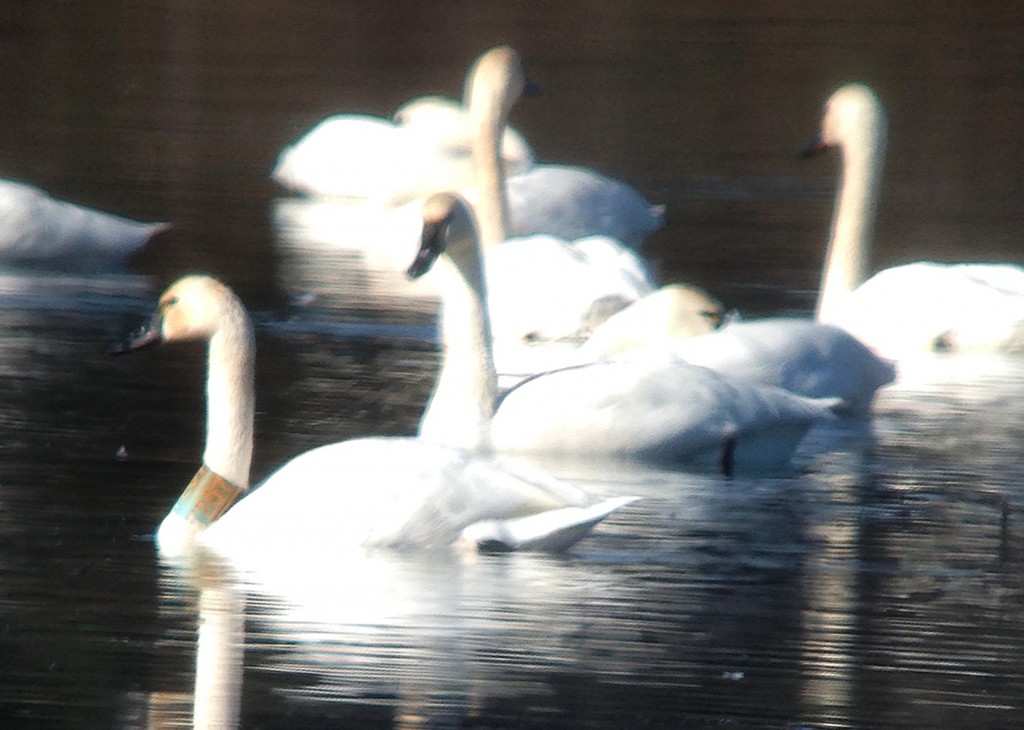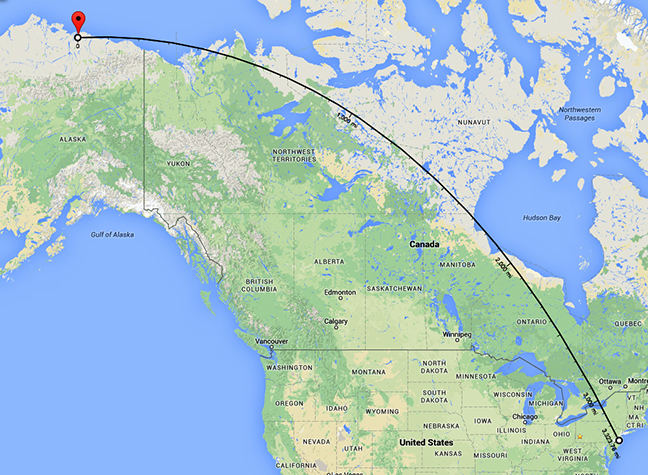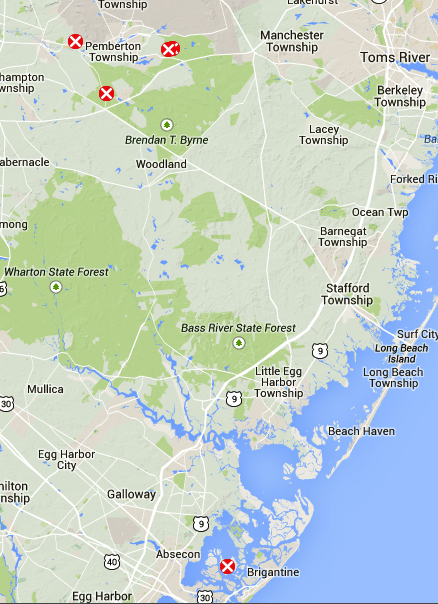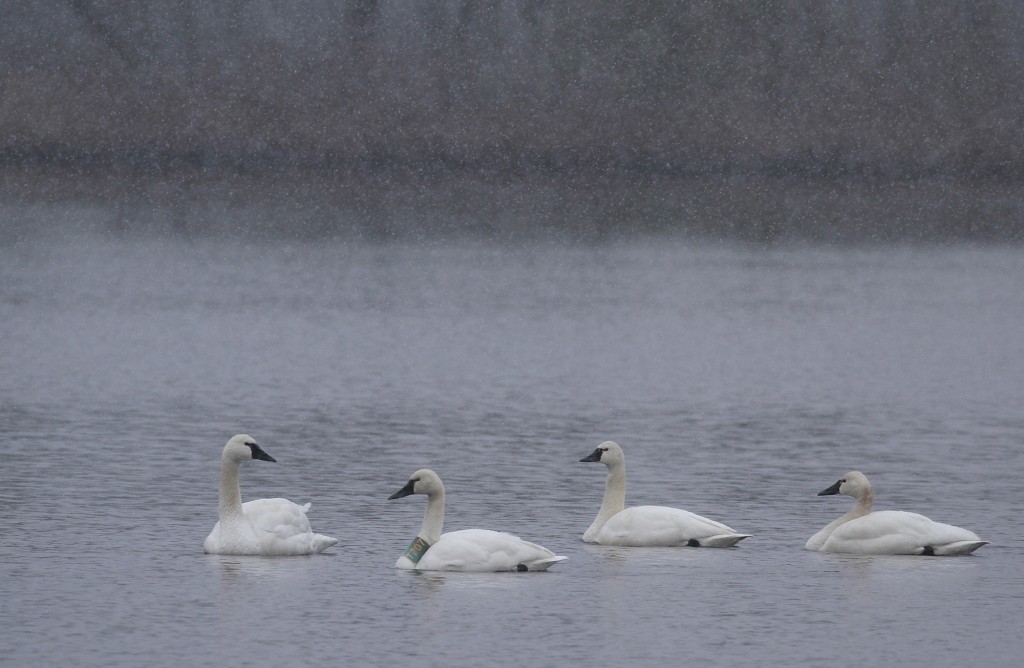Note: This post is from 2015. For the more recent 2016 update, click here.
When November comes around, I start looking for a bird. I don’t mean that I start looking for a particular species; I mean that I look for a very specific individual. And this morning I found her again: Tundra Swan T207. She and I have a history now that goes back three years. Here’s the updated story.
In November 2013 I became aware of a Tundra Swan with a neck collar that was seen at Whitesbog. Bill Elrick spotted this banded swan but was unable to identify the band number. I went back the next day and was able to read the band identification number through my scope and get documentation photos. After reporting the sighting and photo to the Bird Banding Lab (https://www.pwrc.usgs.gov/bbl/bblretrv/index.cfm), I learned that this swan, T207, was banded about as far away as you can get from New Jersey and still be in North America. This swan was a female that was hatched in 2005 or earlier and was banded in July 2006 20 miles from Nuiqsut on the far north shore of Alaska, which is ~150 mi east of Barrow, and only ~8 miles from the Arctic Ocean. This was the fourth time that this bird was re-sighted since she was banded, with all sightings being concentrated within a small region of New Jersey. In addition to our Nov. 2013 sighting at Whitesbog, she was spotted in Nov. 2011 near Forsythe NWR (38 miles from Whitesbog), in Nov. 2010 ~6 miles from Whitesbog, and the first sighting that I am aware of was by Bob Cunningham in Whitesbog in Nov. 2008. In other words, if we make the reasonable assumption that she is returning to the site in Alaska where she was hatched and banded, then she is traveling ~6,700 miles round-trip between Alaska and NJ, perhaps each year.
The wonderful thing about submitting information such as a banded bird, is that you are drawn into learning more about that species. I learned that Tundra Swans that breed in Alaska travel southwards in either of two patterns. A population that breeds in western Alaska heads southwards towards British Columbia and then travels further south along the Pacific coast, primarily wintering in California, while a second population that breeds on the north shore of Alaska heads eastward from British Columbia, migrating across Canada and the Great Lakes region to the east coast of the US, with most wintering in the Chesapeake Bay region and the North Carolina coast. Tundra Swans are known to live up to 24 years in the wild, but average a 15-20-year lifespan.
I was wondering if T207 would return back to our area, so when the swans returned again last year (November 2014), I drove through Whitesbog occasionally, scanning through the flock of up to ~90 Tundra Swans, hoping to see her again, but to no avail. Did she decide to go elsewhere? Was it too early in the season for her to return? Did she meet an early demise? (although by the aging criterion described above, she is still a youngster). I decided to look elsewhere, and finally, in a flooded bog ~ 5 miles away from Whitesbog (39.90260, -74.54057), I saw a distant bird in my binocs with a neck collar. Could it be her, or another swan visiting from the arctic? After quickly setting up the scope, I was happy to see the identifier T207 on a powder blue neck collar. That meant that she arrived back again in NJ for at least the 5th time in the last 7 years, and remarkably returned to within ~5 miles of where she was spotted in 2008, 2010, and 2013. Somehow it shouldn’t be surprising that birds have the remarkable ability to travel more than 3,000 miles and then navigate back to the same location, but I’m still amazed.
As you can imagine, I’ve been wondering if she would return and be sighted in the area for yet another year. After all it’s 6,700 miles back and forth between here and Alaska, with all kinds of hazards. And if her navigation skills are off by just a little bit, she could end up in a lake just a few miles away and we might never notice her. I’ve been popping into the local bogs around once per week hoping to see her. Today there were only 8 swans in Whitesbog, all collarless. Five miles away in Reeve’s Bog, there was a more impressive group of 93 Tundra Swans, so the odds were better, but on the first scan through, none with a collar. From another vantage point, still no collars were visible. Finally, one more try as the flock raised their heads in response to a passing truck, and this time there it was! A faded, worn, and dirty collar with T207 emblazoned across it. As if it’s not amazing enough that she finds her way back to this area of New Jersey each year, the location that I found her today is a grand total of ~200 yards away from where I spotted her last November. Now that’s what I call navigation skills! I’m thrilled that she survived and that we have her back again here in New Jersey for another winter.

She’s back again. A digiscoped photo of Tundra Swan T207, Nov. 25, 2015. Her ‘necklace’ is a bit worn and dirty, but it’s still good to see her.
You can bet that I’ll be looking for her again next year. I’m beginning to wonder who is going to be returning to Whitesbog longer…her or me?
Addendum to this entry: in early 2016, T207 was found in at least two other local lakes, so even though she returns faithfully to our area, she still moves around locally during the season. On Jan. 9, 2016 she was found in Bamber Lake (Ocean County) by Linda Walter, and on Jan. 17 she was found by Bob Cunningham again in Whitesbog. More additions to an already cool story.


